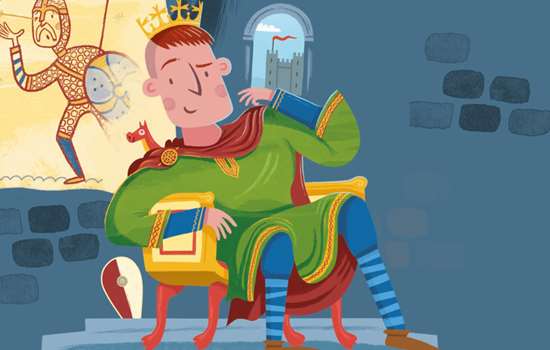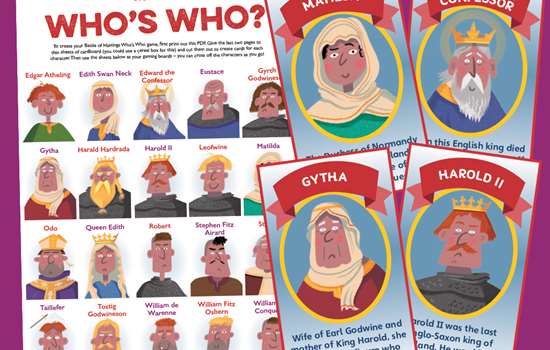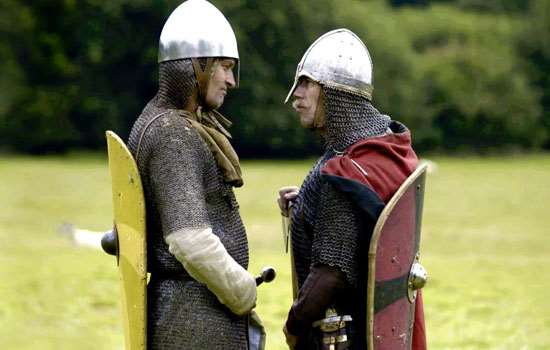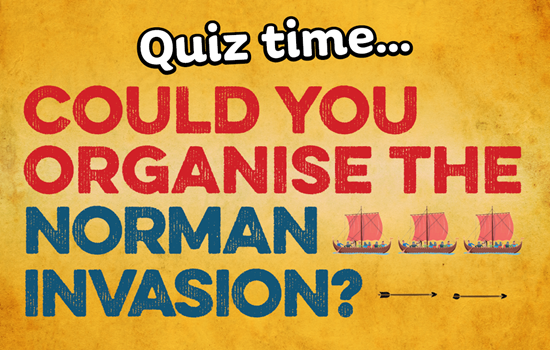Learn to draw William the Conqueror with Kids Rule! magazine illustrator Wesley Robins! Have a piece of paper and a pen or pencil ready and follow Wesley's simple step-by-step instructions. Then, add your own finishing touches using coloured pencils, pens or paints.
We'd love to see your finished artwork and we'll share our favourites in a gallery on this page. Make sure you have your parent or guardian's permission to email it to us at members.magazine@english-heritage.org.uk, along with your name and age.
About William the Conqueror (or William I)
- Born: about 1028 in Falaise, France
- Parents: Robert, Duke of Normandy and Herleva
- Became king: 1066
- Reigned: 20 years and 8 months
- Died: 9 September 1087 in Rouen, France
- Successor: William II (William I’s son)
William was the child of Robert 'the Magnificent', Duke of Normandy and Herleva, the daughter of a leatherworker, called a ‘tanner’. His parents were not married, and not thought to have equal status in society. Both things were important to people at this time, so William’s enemies mocked him, calling him 'William the Bastard' or 'William the Tanner'.
William’s father died when he was seven, and after he was officially declared an adult (aged fifteen) he often had to fight for his dukedom. This made him a brave and resourceful warrior. He was tall and exceptionally strong, had a loud harsh voice and a frightening appearance.
Although William was loyal to the Church and faithful to his wife, Matilda of Flanders, he could also be cruel, greedy and ruthless. But his toughness and determination made William I one of England's most effective rulers ever.
Conquering a country
William was a Norman, descended from Vikings who settled in Normandy in France. In 1066, William and his army sailed over to England and changed the course of British history.
When the English king Edward the Confessor died without an heir, three men claimed the throne as theirs. Two of these, Harold of the Anglo-Saxons and Harald of the Norwegians, fought a battle in northern England, while Duke William and his Norman army landed in the south.
Harold and the Anglo-Saxons won the first battle but, after a long march to meet William’s army, they were defeated at the famous Battle of Hastings, which made William the new king of England.
Click below to catch up with William and Harold as they prepare for the Battle of Hastings...
Meet William and HaroldA crown for Christmas
After fighting desperately to win the throne, William wanted to wait for his wife to come to England from Normandy to be at his coronation, but some English people were worried that the country didn’t have a crowned king, so they wanted him to do it straight away. William was under pressure from the Normans too: they wanted the rewards they’d been promised for taking part in the invasion and could only get them once William was crowned.
So, William agreed, and the ceremony took place at Westminster Abbey in London, on Christmas Day in 1066.
However, not everyone was happy. Many English survivors of the Battle of Hastings and the families of men who’d died lived in London, so during the coronation, guards stood outside the abbey. According to one story, when they heard the congregation shouting their oaths to support William, the guards panicked and thought the English were attacking! They set fire to nearby buildings, and people in the church ran away in fear. William stayed seated as the bishops quickly finished the ceremony. By the end, William was said to have been shaking from head to toe.
Kings of the castles
Over the next few decades, William took control of the whole country by building lots of motte-and-bailey castles. These were made of wood and earth and were eventually replaced with huge stone castle buildings.
New churches were built and the laws, language and everyday life were different. Ordinary people now had to work for William’s knights and barons who owned all the land. They demanded food and taxes from the people and spoke French instead of English. In fact, we still use many words that come from the Normans, such as favourite, soldier and even custard!
Building an Abbey at Battle
According to the Chronicle of Battle Abbey, William made a speech immediately before the Battle of Hastings in which he promised to build a monastery. However, it is more likely that he built Battle Abbey because of the penances that the bishops of Normandy told William and his men to do, to make up for the violence of the Norman Conquest. The monks of Battle would have prayed for the souls of all those who died at the Battle of Hastings, both Norman and Saxon.
There is also evidence that William wanted the abbey to act as a memorial to his great victory, and the events of 1066 were remembered there long after he died. And it wasn't all about William: in the church, there were boards painted to represent the 354 families who had participated in the Conquest.
The Oath of Sarum
In 1086, 20 years after the conquest, the country was in crisis. William was facing rebellions and invasion. On 1 August, he hosted a great gathering at Old Sarum in Wiltshire, where all of the landowners in England swore an oath of loyalty to William. The oath also made sure that if one of those men rebelled against the king, then those who served him would be loyal to the king, not to the rebel lord.
Old Sarum was also the place where the returns from the Domesday survey were collated. This huge survey recorded everyone who owned land in England. By the summer of 1086 it was completed, and the results were available for the king to see. It might have been deliberately timed to match the oath ceremony on 1 August, to show the knights and barons that owning any land in England depended on their loyalty to the king.
The Norman legacy
William I died in September 1087, in France and was buried there rather than in England. His lands in Normandy, the English throne and his wealth were split between his three surviving sons:
- The eldest, Robert, was made Duke of Normandy
- The second, William Rufus, became King William II of England
- The third son, Henry, was given a large amount of money to purchase some land
However, after William II died in a hunting accident, the youngest son Henry became King Henry I of England. He then invaded Normandy and defeated his oldest brother Robert, becoming Duke of Normandy too. This meant all of his father’s lands, titles and wealth were back together again, and English kings and queens used French symbols on their coats of arms for hundreds of years afterwards.




